The hamstring, though often overshadowed by its counterpart, the quadriceps, is one of the most pivotal muscle groups in the human body. Found at the back of the thigh, strong hamstrings aren’t just important for athletes or fitness enthusiasts; they play a crucial role for everyone, irrespective of age or profession.
First and foremost, the hamstring muscles are pivotal in supporting the thighs and knees. A strong set of hamstrings ensures overall leg strength, giving you the power to carry out daily activities such as walking, running, and climbing stairs with ease. They also play a key role in stabilizing movements, reducing the risk of falls and injuries.
Apart from the functional benefits, there’s an aesthetic angle to it too. Toned hamstrings lend a sculpted appearance to the legs, making them look leaner and more defined. Whether you’re wearing a dress, shorts, or just feel like flaunting your legs, well-defined hamstrings can significantly boost your confidence.
In a world increasingly gravitating towards health and fitness, hamstring strength is not a topic to be overlooked. Whether your goals are functional, aesthetic, or both, investing time in strengthening these muscles can yield rewarding results.
Anatomy of the Hamstring
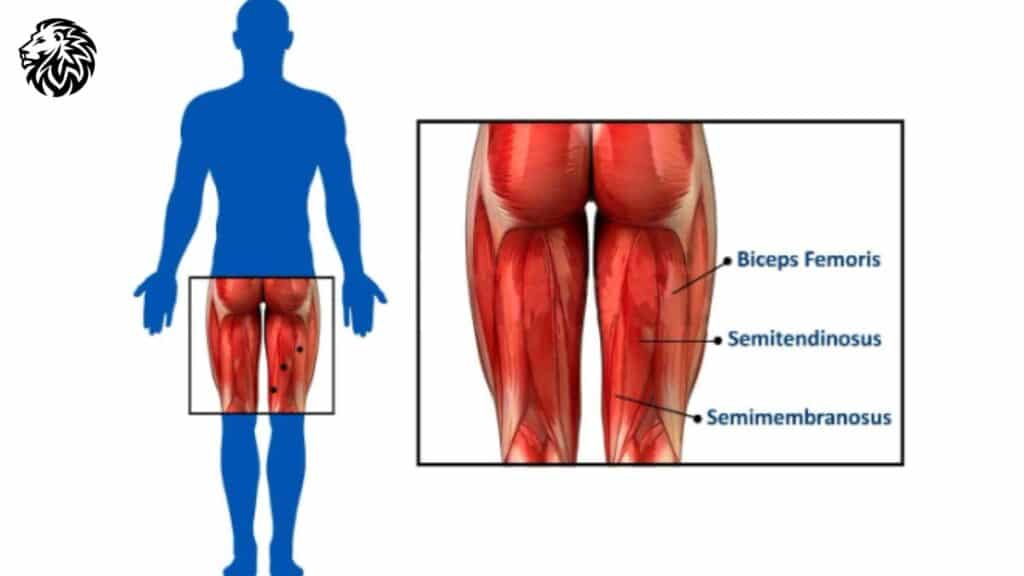
The hamstring isn’t just a single muscle; rather, it’s a group of muscles and tendons located at the back of the thigh. Collectively, they play a pivotal role in flexing the knee and extending the hip, making them indispensable for a plethora of leg movements.
1. Muscles that Make Up the Hamstrings
- Biceps Femoris: This muscle has two parts – the long head and the short head. The long head originates from the ischial tuberosity (the sit bone), while the short head starts from the femur (thigh bone). Both these heads merge into one tendon, which then attaches to the head of the fibula bone.
- Semitendinosus: Situated medially (towards the inner side) and slightly above the biceps femoris, this muscle originates from the ischial tuberosity and inserts onto the upper part of the tibia (the larger bone in the lower leg).
- Semimembranosus: Located even more medially than the semitendinosus, the semimembranosus also originates from the ischial tuberosity but has its insertion on the medial condyle of the tibia.
2. Function in Leg Movements
- Knee Flexion: When you bend your knee, as in the motion of bringing your heel towards your buttocks, you’re primarily using your hamstring muscles. This movement is evident in activities like running or cycling.
- Hip Extension: This movement is the action of moving your leg backward. It’s evident when you’re pushing off the ground while walking or running. Hip extension is also crucial for movements like standing up from a seated position or climbing stairs.
- Posture and Pelvic Tilt: The hamstrings play a role in maintaining the tilt of the pelvis. Strong hamstrings aid in postural alignment, especially while standing or walking.
The hamstring muscles are instrumental in facilitating a range of motions in our legs, from the simple act of walking to more complex activities like jumping or sprinting. Understanding their anatomy and function is the foundation of optimizing leg strength and ensuring movement efficiency.
Benefits of Strengthening the Hamstrings
The hamstrings, like every muscle group in our body, offer a range of benefits when properly conditioned and strengthened. However, due to their unique position and function, the advantages of having robust hamstrings are particularly noteworthy.
1. Injury Prevention
- Protecting the Knee: A strong set of hamstrings can aid in preventing injuries, especially in the knee area. These muscles act as stabilizers, ensuring that the knee joint is protected from undue strain or sudden, jerky movements.
- Reducing Strain on the Lower Back: Hamstrings also work in tandem with the muscles of the lower back. By maintaining an adequate balance of strength between the quadriceps and the hamstrings, one can reduce the chances of muscle imbalances, which can lead to strains and injuries.
2. Improved Athletic Performance
- Acceleration and Speed: For athletes, especially those involved in running sports, powerful hamstrings translate to better acceleration and top-end speed. This can make the difference in sports where split-second decisions and actions matter.
- Power Generation: Sports that require jumping, such as basketball or volleyball, benefit from strong hamstrings as they play a significant role in generating upward thrust.
3. Enhanced Balance and Stability
- The hamstrings, in conjunction with other leg muscles, contribute to our overall balance. A strengthened hamstring ensures that we have a stable base, reducing the likelihood of falls and mishaps.
- This enhanced balance is especially beneficial for the elderly and those involved in sports that require a lot of pivoting, like tennis or dancing.
4. Aesthetic Appeal
- Sculpted Legs: Toned hamstrings lend a defined curve to the back of the thighs, providing an aesthetically pleasing contour and shape.
- Lifted Buttocks: The hamstrings are connected to the glutes. When strengthened, they can give the buttocks a more elevated and toned appearance, enhancing the overall profile of the lower body.
5. Reduced Lower Back Pain
- Better Posture: Strong hamstrings contribute to a neutral pelvic position, which in turn leads to a better spinal alignment. This can help in alleviating or preventing the onset of lower back pain.
- Support During Lifting: When lifting heavy objects, the power should come from the legs and not the back. Strengthened hamstrings ensure that the force exerted during lifting is distributed properly, reducing undue stress on the lower back.
In essence, strengthening the hamstrings doesn’t just cater to athletes or those looking to enhance their physical appearance. It’s a holistic approach to better health, stability, and daily functionality, making hamstring exercises a valuable inclusion in any fitness regimen.
7 Powerful Hamstring Exercises For Women
1. Stiff-legged Deadlifts
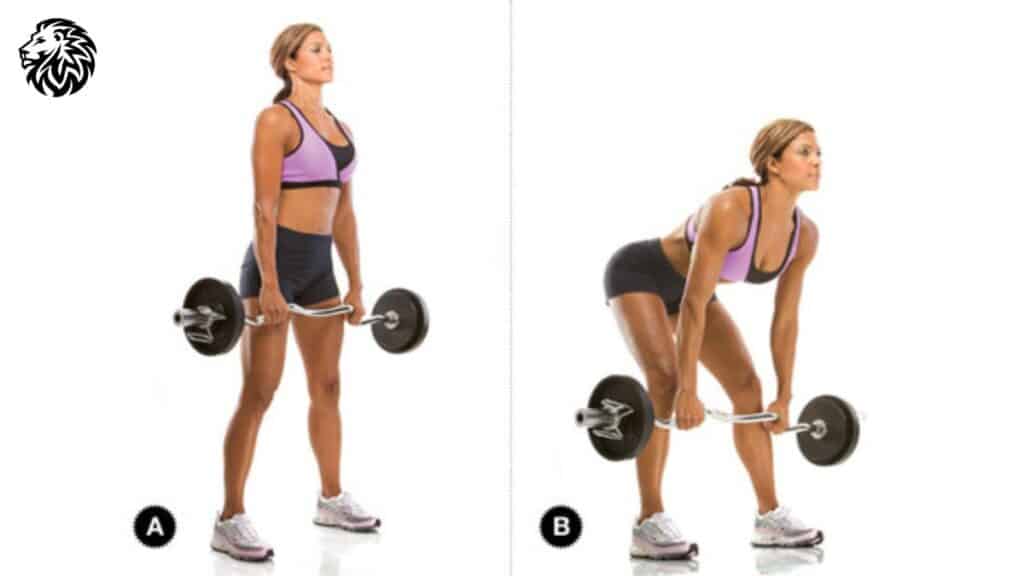
- Description and Benefits:
- Stiff-legged deadlifts, sometimes referred to as Romanian deadlifts, primarily target the hamstrings, glutes, and lower back.
- They are fantastic for building strength and muscle endurance in the posterior chain.
- Regular incorporation of this exercise can improve posture, enhance core stability, and increase functional strength.
- How to: Step-by-step instructions:
- Stand upright with feet hip-width apart and hold a barbell or dumbbells in front of you with an overhand grip.
- Keep your knees slightly bent but fixed in this position throughout the movement.
- Engage your core and maintain a straight back as you hinge at the hips to lower the weights.
- Lower the weights only as far as you can without rounding your back, ideally until they are mid-shin or just below the knees.
- Use your hamstrings and glutes to pull the weights back up and return to the starting position, fully extending your hips at the top.
- Common Mistakes and How to Avoid Them:
- Rounding the Back: Always ensure your back is straight. Engaging your core and thinking about “pushing” your chest out can help maintain this position.
- Going Too Low: Don’t prioritize depth over form. Only go as low as your flexibility allows without compromising your back’s position.
- Locking the Knees: Keep a slight bend in the knees to prevent joint strain and ensure the hamstrings are effectively engaged.
2. Hamstring Curls (using a machine or resistance bands)
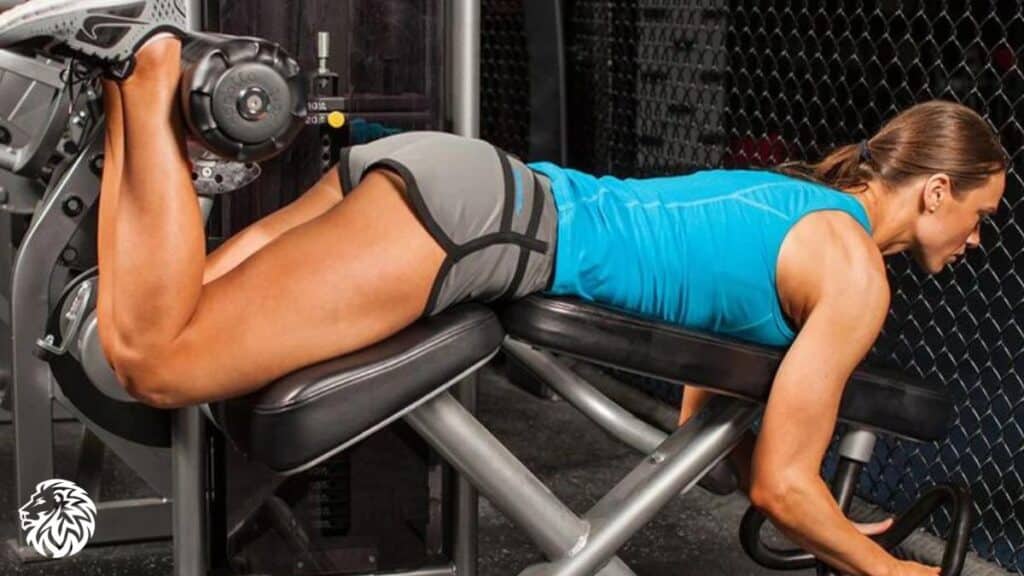
- Description and Benefits:
- Hamstring curls specifically isolate the hamstring muscles.
- They are ideal for building muscle definition and enhancing joint flexibility.
- Using resistance bands or machines can provide consistent tension, ensuring effective muscle engagement throughout the movement.
- How to:
- Machine-Based:
- Lie face down on a hamstring curl machine with the back of your ankles positioned under the padded lever.
- Ensure your knees are just off the edge of the bench.
- Curl your heels towards your glutes, contracting your hamstrings.
- Slowly lower back down and repeat.
- Resistance Band:
- Lie face down and loop a resistance band around your ankles.
- Hold onto the ends of the band with your hands placed in front of you.
- Curl your heels towards your glutes, creating tension in the band.
- Slowly return to the starting position and repeat.
- Machine-Based:
- Tips for Effective Performance:
- Controlled Movement: Ensure the movement is slow and controlled, focusing on the contraction of the hamstrings and avoiding using momentum.
- Avoid Hyperextending the Back: Keep your hips and pelvis grounded on the machine or floor to prevent putting unnecessary pressure on the lower back.
- Adjust Resistance Appropriately: Choose a resistance level that is challenging but allows for proper form. It’s better to start light and gradually increase resistance as you become more accustomed to the exercise.
3. Glute Bridges
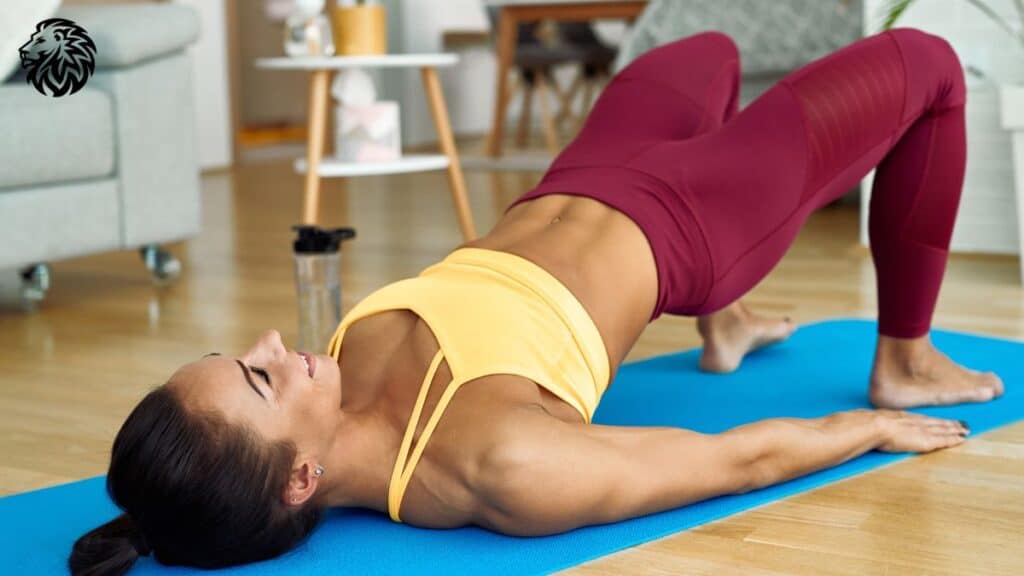
- Description and Benefits:
- Glute bridges target the hamstrings, glutes, and lower back.
- They help strengthen the posterior chain, essential for improved posture and reducing lower back pain.
- This exercise aids in activating the glutes, which can be under-engaged in people who sit frequently.
- How to:
- Lie flat on your back on a mat, with your knees bent and feet flat on the ground. Your feet should be hip-width apart.
- Place your arms at your side, palms facing down.
- Press through your heels and lift your hips off the ground by squeezing your glutes. Your body should form a straight line from your shoulders to your knees at the top of the movement.
- Lower your hips back down to the starting position and repeat.
- Variations: Single-leg Glute Bridge:
- Begin in the same starting position as the standard glute bridge.
- Extend one leg straight out.
- Press through the heel of the foot that’s on the ground and lift your hips.
- Lower your hips back down and switch legs.
4. Swiss Ball Hamstring Curls
- Description and Benefits:
- This exercise targets the hamstrings while also engaging the core and glutes.
- Using the Swiss ball introduces an element of instability, enhancing muscle activation and balance.
- Swiss ball hamstring curls can improve hamstring flexibility and joint stability.
- How to:
- Lie flat on your back on a mat and place your heels on top of a Swiss ball. Your legs should be straight, and arms should be at your sides for stability.
- Lift your hips off the ground, engaging your core and glutes.
- Bend your knees and pull the Swiss ball towards you using your hamstrings.
- Push the ball back out to the starting position and repeat.
- Modifications for Beginners:
- Reduced Range of Motion: Start by moving the ball a smaller distance toward you and gradually increase as you become more comfortable.
- Stability: If balancing on the Swiss ball is challenging, position the ball closer to your glutes, reducing the lever length.
- Isometric Holds: Instead of curling the ball in and out, simply hold the bridge position with your heels on the ball. As your strength and stability improve, begin to incorporate the curls.
5. Walking Lunges

- Description and Benefits:
- Walking lunges are a dynamic exercise that targets the quads, hamstrings, glutes, and calves.
- They enhance lower body strength, improve balance, coordination, and hip flexibility.
- Engaging the hamstrings during the movement ensures better stability and power in each lunge step.
- How to:
- Start by standing upright with your feet hip-width apart.
- Take a step forward with your right foot and lower your body until both knees form a 90-degree angle. Ensure the back knee hovers just above the ground.
- As you’re lowering, emphasize engaging your hamstrings by pulling your heel towards your glutes.
- Push through the heel of your front foot, engaging the hamstrings and glutes, to bring yourself up and step forward with the left foot, repeating the lunge.
- Continue alternating legs as you walk forward.
- Emphasis on the Hamstring Engagement During the Movement: Engaging the hamstrings during walking lunges adds stability to the movement, prevents the knees from overshooting past the toes, and aids in the upward thrust as you transition between steps. It also ensures balanced muscle activation between the quads and hamstrings.
6. Nordic Hamstring Curls
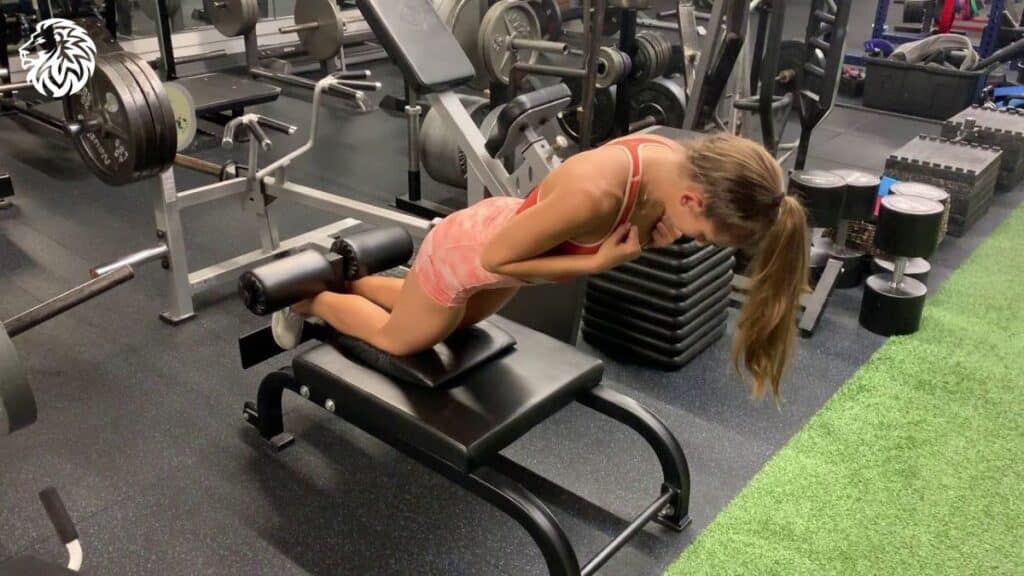
- Description and Benefits:
- Nordic hamstring curls, also known as natural leg curls, are one of the most effective exercises for isolating and strengthening the hamstrings.
- They help prevent hamstring strains, improve muscle balance in the posterior chain, and enhance sprinting capabilities.
- How to:
- Partner-Based:
- Kneel on a padded surface with your feet hip-width apart.
- Have a partner hold your ankles firmly to the ground.
- Engage your core and hamstrings, then slowly lower your body forward, resisting the pull of gravity.
- When you can’t resist further, use your hands to push yourself back up to the starting position.
- Solo Execution (using equipment):
- Kneel in front of an anchored barbell or other sturdy equipment that can safely hold your ankles.
- Slide your ankles under the bar or equipment to secure them.
- Perform the curl as mentioned in the partner-based method.
- Partner-Based:
7. Single-leg Romanian Deadlift
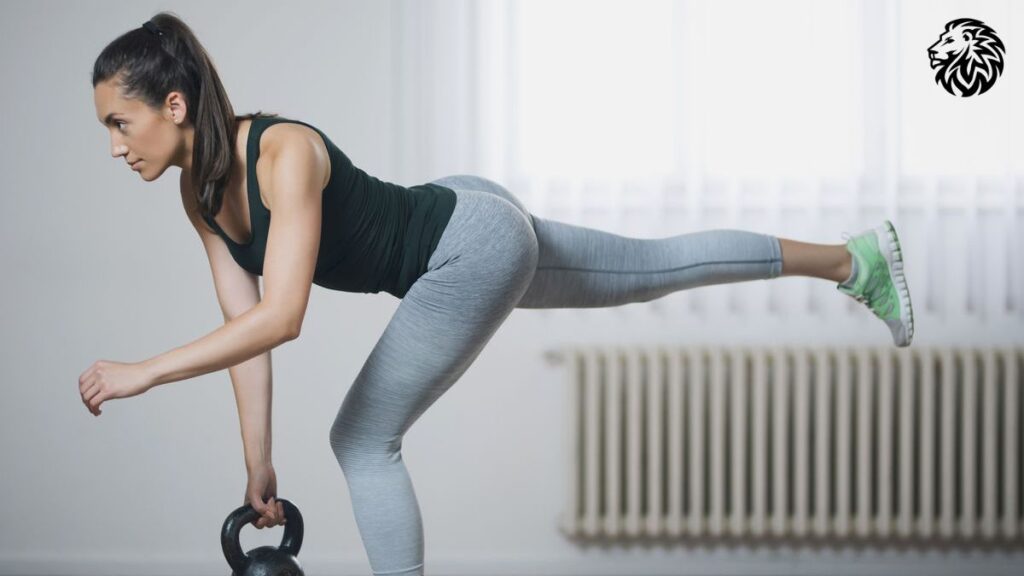
- Description and Benefits:
- The single-leg Romanian deadlift (RDL) is a unilateral exercise that focuses on the hamstrings, glutes, and lower back.
- It improves balance, stability, and strength in the posterior chain, while also enhancing core engagement due to the single-leg stance.
- How to:
- Start by holding a dumbbell or kettlebell in your right hand.
- Stand on your left leg with a slight bend in the knee.
- Hinge at the hips, keeping your back straight, and lower the weight towards the ground while extending your right leg straight back.
- Engage your left hamstring and glute to return to the starting position.
- Switch sides after completing the desired reps.
- Balance and Focus: Concentrate on a fixed point on the ground to help maintain balance. Additionally, engaging the core throughout the movement will add stability. If balance is a challenge, performing the movement near a wall or holding onto a sturdy support with the free hand can help until stability improves.
Incorporating these exercises into a workout routine provides a comprehensive approach to hamstring strengthening, from dynamic movements like walking lunges to highly isolated exercises like Nordic curls. Remember to prioritize form and quality of movement over weight or reps.
Tips for Safe Execution
- The Importance of Proper Form:
- Foundation for Results: Proper form ensures that the targeted muscles are engaged and that the exercise’s benefits are maximized.
- Injury Prevention: Incorrect form can lead to muscle imbalances, strains, or more serious injuries. Maintaining good form ensures that stress is placed on the intended muscles and joints, reducing the risk of harm.
- Efficiency: By using the right form, less energy is wasted on unnecessary movements, making your workout more effective.
- Listening to One’s Body and Knowing When to Modify or Stop:
- Body’s Feedback System: Pain, sharp discomfort, or unnatural strains are signs from the body that something may be wrong. It’s essential to distinguish between the discomfort of a challenging workout and pain that signifies potential injury.
- Adapt and Modify: Not every exercise is suitable for everyone. Depending on individual differences, such as flexibility, strength levels, and previous injuries, some movements might require modification. For instance, those with knee issues might opt for a stationary lunge over walking lunges.
- Rest and Recovery: If certain muscles or joints feel particularly sore or overworked, it might be beneficial to give them extra rest before targeting them again. Overtraining can lead to decreased performance and increased risk of injury.
- Using Appropriate Weights and Resisting the Urge to Overdo It:
- Start Slow: Especially for beginners or when trying out a new exercise, it’s better to start with lighter weights and focus on mastering the form. As you become more comfortable, gradually increase the weight.
- Progressive Overload: While it’s essential to challenge oneself to ensure muscle growth and strength gains, it should be done progressively. This means gradually increasing the weight or resistance over time, rather than making large jumps.
- Avoid Ego Lifting: Lifting weights that are too heavy, often driven by ego or the desire to impress, can compromise form and lead to injury. It’s more beneficial and safe to use weights that allow for full range of motion and proper technique.
- Rest Periods: Allow sufficient time between sets to recover. When lifting heavy, the muscles need time to recuperate to perform effectively in subsequent sets. Rushing through sets with insufficient rest can lead to fatigue, which may compromise form.
By adhering to these safety guidelines, you not only protect yourself from potential injuries but also ensure that your training yields the best possible results. Remember, in the realm of fitness, consistency coupled with safety is the key to long-term success.
Incorporating Hamstring Exercises into a Workout Routine
- Suggestions for Creating a Balanced Leg Day Workout:
- Full Leg Engagement: While the focus may be on the hamstrings, it’s essential to create a balanced leg day routine that also targets the quadriceps, calves, and glutes. Incorporate exercises like squats, leg presses, and calf raises.
- Exercise Sequence: Begin with compound exercises, such as squats or deadlifts, that target multiple muscle groups. This allows you to utilize the most energy early in the workout. Then, move to isolation exercises, like hamstring curls or glute bridges.
- Mix of Strength and Endurance: Combine heavier weight exercises with fewer reps (for muscle building and strength) and lighter weight exercises with more reps (for endurance and toning).
- Functional Movements: Add in exercises that mimic daily activities or functional movements, such as step-ups or walking lunges.
- How Often to Train Hamstrings:
- Frequency: For most people, training hamstrings directly 1-2 times a week is sufficient. This ensures that they receive adequate stimulation while preventing overtraining.
- Split Routines: If following a split routine where different body parts are trained on different days, incorporate hamstrings on leg day or posterior chain-focused days.
- Importance of Allowing Adequate Recovery:
- Muscle Repair and Growth: Muscles grow and repair during rest, not while you’re working out. Without adequate recovery, you’re not giving your hamstrings the opportunity to recover and grow.
- Avoiding Overtraining: Training the hamstrings too frequently or without enough rest can lead to overtraining, which can decrease strength and muscle mass and increase the risk of injury.
- Recovery Tips:
- Active Recovery: Gentle activities like walking, cycling, or yoga can aid in muscle recovery by increasing blood flow without straining the muscles.
- Stretching: Post-workout, incorporate hamstring stretches to increase flexibility and reduce muscle tightness.
- Sleep: Ensure you’re getting enough sleep, as this is when a lot of muscle repair happens.
- Nutrition: Consume a mix of protein and carbohydrates post-workout to aid in muscle recovery and replenish glycogen stores.
While hamstring exercises play a pivotal role in a comprehensive leg routine, it’s essential to approach them with a balanced perspective. By giving equal attention to all leg muscles, practicing safe training habits, and allowing for appropriate recovery, you’ll be setting yourself up for optimal strength gains and long-term fitness success.
Conclusion
The hamstrings, often overshadowed by their counterparts in the quadriceps or the allure of sculpted calves, play an invaluable role in our overall leg strength, aesthetic appeal, and daily functional movements. This article has delved into seven potent exercises that can help women tap into the power of these muscles, ranging from the intensity of the Stiff-legged Deadlifts to the balance challenge of the Single-leg Romanian Deadlift.
To recap:
- Stiff-legged Deadlifts offer a compound movement targeting both hamstrings and glutes while promoting hip flexibility.
- Hamstring Curls, whether machine-based or with resistance bands, specifically target the hamstring muscles, refining their shape and strength.
- Glute Bridges are not just for the glutes; they are pivotal for hamstring engagement and posterior chain strengthening.
- Swiss Ball Hamstring Curls bring in an element of core stability and focused hamstring contraction.
- Walking Lunges, while often associated with quads, provide a dynamic way to activate and strengthen the hamstrings.
- Nordic Hamstring Curls are arguably one of the most effective hamstring isolators, challenging even seasoned athletes.
- Lastly, the Single-leg Romanian Deadlift not only hones in on hamstring strength but also fine-tunes balance and proprioception.
For women navigating the extensive world of fitness, it’s essential to remember that every muscle group has its unique role and importance. The hamstrings are no exception. They provide stability in our strides, power in our jumps, and grace in our movements. Prioritizing their strength ensures not just toned legs but also a foundation for better posture, reduced injury risks, and enhanced athletic performance.
So, as you plan your next leg day or reassess your fitness journey, don’t let the hamstrings fade into the background. Embrace these exercises, honor the strength and resilience of your body, and let your hamstrings shine in their full glory. Your body will thank you for it!
References and Further Reading
- TrainHeroic. (n.d.). Best hamstring exercises. TrainHeroic. Retrieved from https://www.trainheroic.com/blog/best-hamstring-exercises/
- Built With Science. (n.d.). Best compound hamstring exercises. Built With Science. Retrieved from https://builtwithscience.com/fitness-tips/best-compound-hamstring-exercises/
- American Council on Exercise. (2018, February). ACE-sponsored research: What is the best exercise for the hamstrings? ACE Fitness. Retrieved from https://www.acefitness.org/continuing-education/certified/february-2018/6896/ace-sponsored-research-what-is-the-best-exercise-for-the-hamstrings/
- Real Simple. (n.d.). Hamstring exercises and stretches. Real Simple. Retrieved from https://www.realsimple.com/health/fitness-exercise/workouts/hamstring-exercises-stretches
- Northeast Texas Community College. (n.d.). Hamstring exercises. NTCC. Retrieved from https://www.ntcc.edu/athletics/live-athlete/exercises/hamstring-exercises







